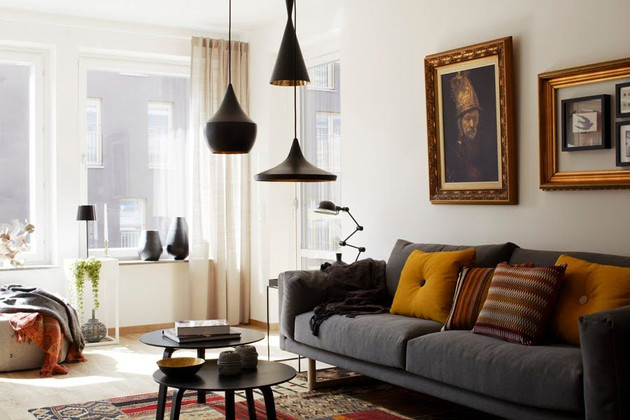LED Spotlight: The Best Room Lighting Tips
Sep 1st 2020
Good lighting is crucial to any space - especially living spaces. Your home is a reflection of you: your likes, tastes, personality. What you value is on display, not just for others who come over and visit from time to time, but for yourself. According to William Peace of Peace Design in Atlanta, “Lighting is probably the most important thing you can do in an interior. You can design the most beautiful space, and if you don’t light it well, nobody really sees it, and it doesn’t matter.”
So let’s take a look at how to tackle that most important component of your home and review some quick lighting tips for each room.
One of the biggest trends right now is in decorative lighting. Chandeliers and big, bold fixtures are making a huge come back. If you read our article on this decade’s lighting trends, this won’t come as a surprise. These ornamental, often ostentatious fixtures are pieces of art and are as much an expression of your style as anything else you put in your space. People often associate chandeliers with dining rooms, but modern lighting trends see the addition of chandeliers in living rooms, bedrooms, and even bathrooms if there is enough space and high enough ceilings.
Living rooms benefit from decorative sconces and lamps that provide soft, diffuse light. Keeping sconces and lamps on dimmers also gives you extra control over the light in your space. When choosing a lampshade, there are many options. Many home decor companies will sell their lamp bases and shades separately, meaning you have nearly an infinite number of mix and match options. The key to lamp and lampshade combinations is coordinating with the overall feeling of the room. Something to consider is if you want a light- or multi-colored shade that draws attention to it and puts out a lot of light, or something darker and richer for a moodier feeling that sends light in more of a vertical direction. Usually a lamp’s color comes from the base and the shade is more neutral but it certainly doesn’t always have to be that way. Aside from the shade’s color and its size, it’s also important to consider texture, which can also add an important dimension to a room. Depending on the textures already in the room you may want to complement them or go in a completely different direction. Ultimately it’s up to you and the style you wish to put forth.
If you have a large shared living space, an open floor plan, rather than investing in many small or medium sized fixtures, consider investing in one large piece. A large, statement piece that is really a piece of art in and of itself can become the focal point as well as the space’s main light source. In order not to compete with it, recessed cans and other, smaller, more subtle light sources will help illuminate the rooms without overwhelming the star light fixture.
Similarly, when you have a big open space broken up into different “rooms” or areas of use, you don’t necessarily need to be concerned with “matching” fixtures from area to area. It’s better to find fixtures that complement each other. All the fixtures in the living room may be from the same collection or otherwise match in color, style, shape, etc. But just as you don’t need to match the couch to the dining room table, you don’t have to match the dining room chandelier to the living room sconces. However, you may want to keep your overall home decor in mind, too. Having a hyper modern living room sharing space with a very traditional dining room set may feel more clashing instead of intriguing.
Other options are ones that play with and even defy conventions of scale. No longer are big fixtures reserved for big spaces. Small spaces can make use of large lamps and other movable, impermanent fixtures. Similarly, large spaces, especially modern spaces, can benefit from smaller, simple, minimalist lighting. This doesn’t mean the space itself will be mostly shrouded in shadow, it can still feel light and airy, but the fixtures themselves will fall away in favor of the other decorations.
If ambient and decorative lighting is the star of the living room, task lighting is crucial for bathrooms and kitchens. When it comes to bathrooms, function goes at the top of the list. That can be a pair of sconces for example, for shaving or putting on makeup. The overall room should feel bright enough so you don’t have dark corners. Recessed lights above the shower or bathtub are also important.
Task lighting is also important in the kitchen but takes different forms. In the bathroom you want lighting that is going to illuminate your own face while in the kitchen you want to illuminate your work space. Crucial lights for a well-lit kitchen are pendants over kitchen islands or tables and under-cabinet lights to illuminate the counter top work surfaces. Combine these with recessed or track lights to round out the space and eliminate as many shadows as possible. This will make it easier to work and also easier to clean.
When it comes to lighting your space, there isn’t much you can do “wrong.” It’s all about preference. However, one thing that should be avoided is overlighting a room. Having too many fixtures on too few switches or not employing the use of dimmers can wash out a room and make it feel sterile and uninviting. The key is versatility and having fun with your lighting!
No matter what your style, SunLake lighting has the LED bulbs for nearly any fixture. We’ve picked out just a few to highlight below but you can browse our whole catalog here.


